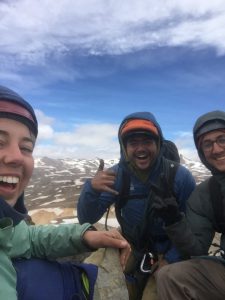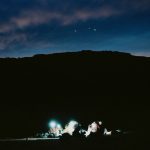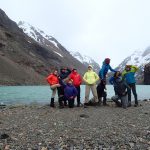HMI Gap: Bienvenidos a Patagonia!
Rock Climbing Group
Written by Nora Fried and Ben Clouse
Bienvenidos a Patagonia! Welcome to Patagonia!
After quite the journey (3 planes, 3 bus rides, and a ferry), our group finally made it all the way from Leadville to Chile Chico, Chile. Spirits were through the roof as we awoke 6,296 miles from the start of our travels. Excited to explore and absorb this new place, we spent the next three days prepping for expedition – what would be an 11-day mixed backpacking and climbing trip to Cerro Colorado. Tackling the challenges of being in a new place, we practiced our Spanish while food shopping and interacting with native Chileans and then packed up to head into the backcountry.
 Our trek began with several days of backpacking – sizing up the new terrain and remembering how to navigate using topographical maps. In awe of the new landscape, we found ourselves fascinated by the unique flora, fauna, and rock (of course) of the Patagonian steppe, the term used to describe the region of Patagonia we were in. Most notable fascinations include the illusive Guanaco, an alpaca-like creature we soon came to idolize and made numerous attempts to befriend (although they didn’t seem that interested in our situation!), the Caracara and Condor, both massive birds who have learned to perfectly circumnavigate the intense winds of the region, and the enchanting “baby dragons,” small, brightly colored lizards who seem to enjoy the heat.
Our trek began with several days of backpacking – sizing up the new terrain and remembering how to navigate using topographical maps. In awe of the new landscape, we found ourselves fascinated by the unique flora, fauna, and rock (of course) of the Patagonian steppe, the term used to describe the region of Patagonia we were in. Most notable fascinations include the illusive Guanaco, an alpaca-like creature we soon came to idolize and made numerous attempts to befriend (although they didn’t seem that interested in our situation!), the Caracara and Condor, both massive birds who have learned to perfectly circumnavigate the intense winds of the region, and the enchanting “baby dragons,” small, brightly colored lizards who seem to enjoy the heat.
 We soon aimed for the base of Cerro Colorado. The remnants of volcanic activity thousands of years ago, this basalt mountain stands high above the landscape, giving off the impression of being an awe-inspiring yet intimidating alpine climbing area, and of being the evil lair of some Disney villain. Spending 7 days at the base of the peak gave us the opportunity to learn how to approach alpine climbing, learn rock rescue skills and put them into action through several scenarios, to practice building anchors and establishing new routes, practice wilderness medicine skills, and to even get on to the top via a ridge traverse or multi-pitch climb.
We soon aimed for the base of Cerro Colorado. The remnants of volcanic activity thousands of years ago, this basalt mountain stands high above the landscape, giving off the impression of being an awe-inspiring yet intimidating alpine climbing area, and of being the evil lair of some Disney villain. Spending 7 days at the base of the peak gave us the opportunity to learn how to approach alpine climbing, learn rock rescue skills and put them into action through several scenarios, to practice building anchors and establishing new routes, practice wilderness medicine skills, and to even get on to the top via a ridge traverse or multi-pitch climb.
Because of the geography of the country, the region of Patagonia is perhaps most known for two things. First and foremost, the wind. We experienced gusts that reached up to 80 mph, complicating simple and daily tasks. A couple examples include: eating food (before it was blown clear off your spoon) and keeping feet firmly on the group while properly layering (a few students experienced their maiden flights!) We were especially confused when we found ourselves in a snowstorm underneath a cloudless sky, which made us hypothesize it was snowing in a neighboring valley. Despite the wind, we also had the privilege to enjoy yerba mate, the second thing Patagonia is well known for. We learned that drinking this caffeinated tea is a traditional way to bring people together, and spent many hours huddled in groups chatting as the mate made its way around the circle.
 On the final day of living in what felt like the most remote and foreign landscape, we, covered with a thick layer of mud and sun, walked back into the town of Chile Chico, ready for a hot meal and excited to continue our journey as we move on to explore Argentina!
On the final day of living in what felt like the most remote and foreign landscape, we, covered with a thick layer of mud and sun, walked back into the town of Chile Chico, ready for a hot meal and excited to continue our journey as we move on to explore Argentina!


 Evening Events in New York & Connecticut
Evening Events in New York & Connecticut
 HMI Gap: Grateful to be in such a wild place
HMI Gap: Grateful to be in such a wild place